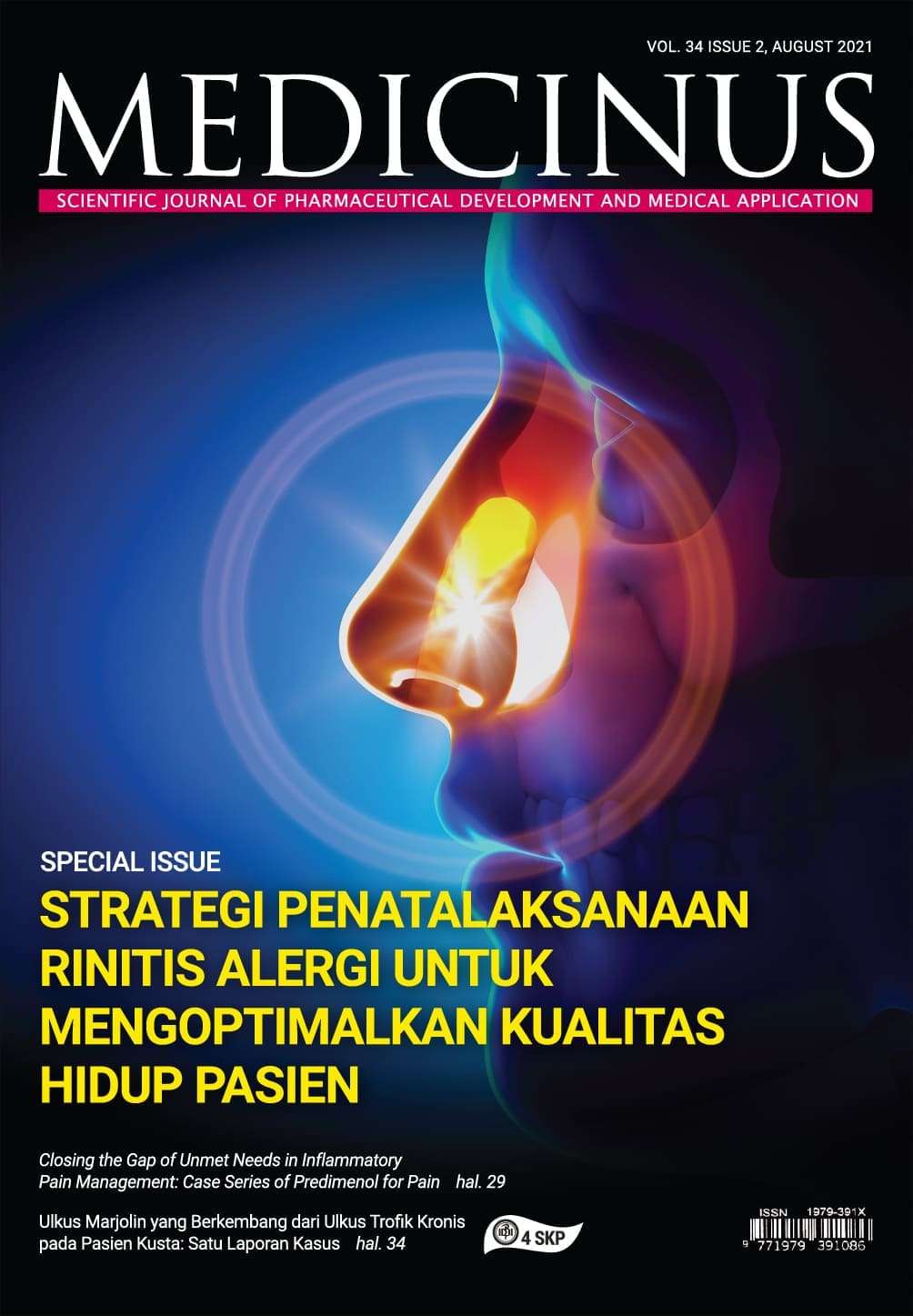Strategi Penatalaksaan Rinitis Alergi untuk Mengoptimalkan Kualitas Hidup Pasien
DOI:
https://doi.org/10.56951/medicinus.v34i2.60Kata Kunci:
rinitis alergi, farmakoterapiAbstrak
Rinitis alergi merupakan kondisi inflamasi pada mukosa hidung yang terjadi setelah paparan alergen dan diperantarai oleh immunoglobulin E (IgE). Rinitis alergi tidak hanya ditemukan oleh para spesialis THT, namun juga banyak ditemukan oleh dokter umum. Gejala umum dari rinitis alergi antara lain hidung tersumbat, rinore, hidung gatal, dan/atau bersin. Adanya dua atau lebih gejala nasal selama lebih dari satu jam per hari dapat digolongkan sebagai suspek rinitis alergi. Diagnosis rinitis alergi dapat dilakukan berdasarkan anamnesis riwayat alergi, penilaian derajat keparahan penyakit menggunakan visual analog scale (VAS) sesuai dengan ARIA guidelines, endoskopi nasal, dan skin prick test (SPT). Tata laksana rinitis alergi terjadi dari menghindari paparan alergen, edukasi pasien, penggunaan irigasi nasal dan beberapa golongan agen farmakologi seperti antihistamine, cromolyn, decongestant, intranasal corticosteroid, allergen-specific immunotherapy, dan reduksi konka. Antihistamine oral merupakan agen farmakologis pilihan yang berperan penting dalam pengobatan rinitis alergi pada semua derajat keparahan. Beberapa waktu terakhir telah tersedia antihistamine generasi kedua yang dilaporkan menunjukkan efektivitas dan keamanan pada pengobatan rinitis alergi, yaitu levocetirizine (efektivitas tinggi), rupatadine (dual antihistamine dengan efek anti-PAF), dan desloratadine (profil keamanan sangat baik). Studi-studi terbaru juga menunjukkan bahwa penggunaan antagonis reseptor leukotriene seperti montelukast terbukti efektif menurunkan gejala nasal keseluruhan termasuk hidung tersumbat.
Unduhan
Referensi
Hoyte FCL, Nelson HS. Recent advances in allergic rhinitis. F1000Res. 2018;7: F1000 Faculty Rev-1333. DOI: https://doi.org/10.12688/f1000research.15367.1
Bousquet J, Khaltaev N, Cruz AA, Denburg J, Fokkens WJ, Togias A, et al. Allergic rhinitis and its impact on asthma (ARIA) 2008. Allergy 2008;63:8-160. DOI: https://doi.org/10.1111/j.1398-9995.2008.01642.x
World Allergy Organization (WAO). Pawanker R, Canonica GW, Holgate ST, Lockey RF, Blaiss MS. White Book on Allergy: Update 2013. Milwaukee, WI: World Allergy Organization; 2013.
Fauzi F, Sudiro M, Lestari BW. Prevalence of allergic rhinitis based on World Health Organization (ARIA-WHO) questionnaire among batch 2010 students of the Faculty of Medicine Universitas Padjadjaran. AMJ. 2015;2:620-5. DOI: https://doi.org/10.15850/amj.v2n4.658
Sutarinda R, Dermawan A, Madiadipoera T. Characteristics of Allergic Rhinitis according Skin Prick Test. 19th ARSR - 2ndIndorhino; Bali: 2018.
Dykewicz MS, Wallace DV, Amrol DJ, Baroody FM, Bernstein JA, Craig TJ, et al. Rhinitis 2020: A practice parameter update. Journal of Allergy and Clinical Immunology 2020;146(4):721-67. DOI: https://doi.org/10.1016/j.jaci.2020.07.007
Bjermer L, Westman M, Holmstrom M, Wickman MC. The complex pathophysiology of allergic rhinitis: scientifc rationale for the development of an alternative treatment option. Allergy Asthma Clin Immunol 2019;15(24):1-15. DOI: https://doi.org/10.1186/s13223-018-0314-1
Price D, Scadding G, Ryan D, Bachert C, Canonica GW, Mullol J, et al. The hidden burden of adult allergic rhinitis: UK healthcare resource utilisation survey. Clin Transl Allergy 2015;5(39):1-12. DOI: https://doi.org/10.1186/s13601-015-0083-6
Hossenbabaccus L, Linton S, Garvey S, Ellis AK. Towards definitive management of allergic rhinitis: best use of new and established therapies. Allergy Asthma Clin Immunol 2020;16(39):1-17. DOI: https://doi.org/10.1186/s13223-020-00436-y
Iv CFS, Montejo JM. Allergic rhinitis in children and adolescents. Pediatr Clin North Am 2019;66(5):981-93. DOI: https://doi.org/10.1016/j.pcl.2019.06.004
Sybilski AJ. Visual analogue scale. A simple tool for daily treatment monitoring in allergic rhinitis. Pediatr Med Rodz 2018;14(3):277–81. DOI: https://doi.org/10.15557/PiMR.2018.0030
Klimek L, Bergmann K, Biedermann T, Bousquet J, Hellings P, Jung K, et al. Visual analogue scales (VAS): Measuring instruments for the documentation of symptoms and therapy monitoring in cases of allergic rhinitis in everyday health care: Position Paper of the German Society of Allergology (AeDA) and the German Society of Allergy and Clinical Immunology (DGAKI), ENT Section, in collaboration with the working group on Clinical Immunology, Allergology and Environmental Medicine of the German Society of Otorhinolaryngology, Head and Neck Surgery (DGHNOKHC). Allergo J Int 2017;26(1):16-24. DOI: https://doi.org/10.1007/s40629-016-0006-7
Nevis IF, Binkley K, Kabali C. Diagnostic accuracy of skin-prick testing for allergic rhinitis: a systematic review and meta-analysis. Allergy Asthma Clin Immunol 2016;12:20. DOI: https://doi.org/10.1186/s13223-016-0126-0
Crobach MJ, Hermans J, Kaptein AA, Ridderikhoff J, Petri H, Mulder JD. The diagnosis of allergic rhinitis: how to combine the medical history with the results of radioallergosorbent tests and skin prick tests. Scand J Prim Health Care 1998;16(1):30-6. DOI: https://doi.org/10.1080/028134398750003377
Hasanuddin SM. Pengaruh imunoterapi spesifik alergen tungau debu rumah terhadap tingkat beratnya gejala penyakit, kualitas hidup, dan kadar serum Foxp3 pada penderita rinitis alergi. Tesis. Bandung. 2015.
Hermelingmeier KE, Weber RK, Hellmich M, Heubach CP, Mösges R. Nasal irrigation as an adjunctive treatment in allergic rhinitis: a systematic review and meta-analysis. Am J Rhinol Allergy 2012;26(5):e119–25. DOI: https://doi.org/10.2500/ajra.2012.26.3787
Ghafar MH, Mohamed H, Mohammad NM, Mohammad ZW, Madiadipoera T, Abdullah B. Mometasone furoate intranasal spray is effective in reducing symptoms and adenoid size in children and adolescents with adenoid hypertrophy. Acta Otorrinolaringologica Esp. 2020;71(3):147-53. DOI: https://doi.org/10.1016/j.otoeng.2019.04.002
Mullol J. Positioning of antihistamines in the Allergic Rhinitis and its Impact on Asthma (ARIA) guidelines. Clinical & Experimental Allergy Reviews 2012;12(1):17-26. DOI: https://doi.org/10.1111/j.1472-9733.2011.01158.x
Krishnamoorthy M, Noor NM, Lazim NM, Abdullah B. Efficacy of Montelukast in Allergic Rhinitis Treatment: A Systematic Review and Meta-Analysis. Drugs. 2020;80(17):1831-51. DOI: https://doi.org/10.1007/s40265-020-01406-9
Klimek L, Bachert C, Pfaar O, Becker S, Bieber T, Brehler R, et al. ARIA guideline 2019: treatment of allergic rhinitis in the German health system. Allergologie select, 2019;3:22-50. DOI: https://doi.org/10.5414/ALX02120E
Akdis M, Akdis CA. Mechanism of allergen-specific immunotherapy: multiple suppressor factors at work in immune tolerance to allergens. J Allergy Clin Immunol. 2014;133(3):621-31. DOI: https://doi.org/10.1016/j.jaci.2013.12.1088
Unduhan
Terbitan
Bagian
Diterbitkan
Unduhan
Lisensi
Hak Cipta (c) 2021 Teti Madiadipoera

Artikel ini berlisensi Creative Commons Attribution-NonCommercial 4.0 International License.




